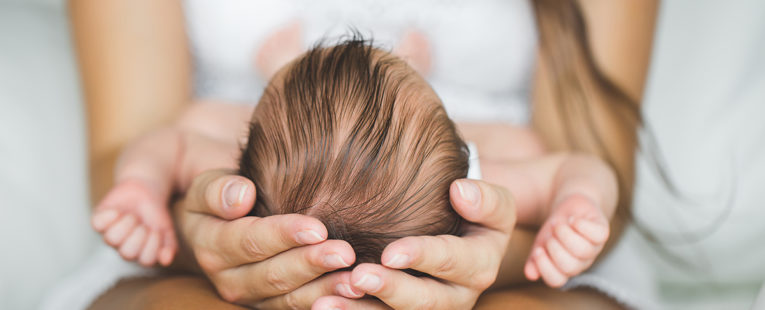Cradle cap, aka seborrheic dermatitis, is a skin condition many infants experience at one time or another.
“It’s very common in infants,” Luis Garcia, MD, a pediatrician at OSF HealthCare, said.
Depending on the case, this condition may look severe, but it’s usually just a run-of-the-mill condition that comes with being a baby.
“Cradle cap is when there are deposits of greasy spots or flakes on your baby’s scalp,” Dr. Garcia said. About 20% of babies will get cradle cap before they’re three months.
You’ll know it by the symptoms you can see: white or yellow scales or flakes, flaky or scaly patches on the scalp, or oily or dry skin on the scalp.
What is the cause of cradle cap inbabies?
There are no specific causes of cradle cap in babies. It’s something that likely just happened because your baby has sensitive skin or has some sort of irritation. Since it is so common, it’s possible that your baby will experience a bout with cradle cap at least once.
“It’s likely just an irritation of the skin. It may also be associated with hyper-sensitive skin.”
How long cradle cap lasts depends on the severity of the case and how sensitive your baby’s skin is.

“Some cases last a few days. Others last a few months,” Dr. Garcia said.
How do you get rid of cradle cap?
“This is a benign condition, which means that it will go away on its own,” Dr. Garcia said. “So how you get rid of cradle cap is to do nothing; just observe it.”
Dr. Garcia also said you can try a couple other cradle cap treatments.
1. Baby oil head massage
The first cradle cap remedy Dr. Garcia recommends is to loosen the flakes with a little bit of baby mineral oil or petroleum jelly. Apply a small amount to your baby’s scalp and gently massage. This should help loosen the flakes. But, Dr. Garcia warns, it’s important not to leave the oil on your baby’s head for too long because that will only make the problem worse.
Once you’ve massaged your baby’s scalp, you can use a fine-toothed comb to gently comb away any flakes that have come loose. Thoroughly wash their head with a soft washcloth, water and gentle baby soap.
2. Talk to your baby’s pediatrician
In certain severe cases, your baby’s pediatrician may prescribe a steroid cream to apply to your baby’s scalp, like hydrocortisone or an anti-fungal cream.
However, only use these remedies if they’ve been prescribed by your baby’s pediatrician. Your baby’s pediatrician knows your baby individually, so they’ll be able to discuss the best course of action you should take to address your baby’s cradle cap. If you use these without the OK from your child’s pediatrician, it may cause more irritation or reactions for your baby.
Want more info?
What not to do
Don’t scratch or pick flakes away. You may feel like it’s helping your baby, but it will likely make the condition much worse.
You also want to avoid putting hats on your baby that trap moisture. You can still use hats to keep the sun out of their eyes or keep their little head warm in the cold months, but make sure you choose a hat that doesn’t hold in moisture. Don your baby in a hat made of breathable fabric, like cotton.
And finally, don’t use harsh soaps, including adult dandruff shampoos. Make sure to use a baby shampoo that’s soft and gentle. You may even want to try a shampoo specially designed for sensitive skin.
You don’t need to use any fancy products, like lotions. This may just cause further irritation.
How to prevent cradle cap
If you want to prevent cradle cap, there are a few things you can do. Poor hygiene will lead to extra oil on your baby’s head, which may cause irritation. The most important is to keep your baby’s head clean and dry. Use a mild baby shampoo during bath time, and make sure you’re washing your baby frequently – about two to three times per week.
Common misconceptions about cradle cap
Pediatricians often hear the same questions from parents about their baby’s cradle cap. Dr. Garcia answered some of the most popular questions to put parents’ minds at ease.
Can baby hair not grow because of cradle cap?
Even though cradle cap can make it look like it’s covering a baby’s head, baby’s hair will still grow. However, it depends on the condition. If your child is suffering from some other condition or had a condition which caused their cradle cap, that condition may cause your child’s hair to not grow.
Is cradle cap the same as dandruff?
Dandruff and cradle cap aren’t exactly the same thing. Dandruff is a symptom and cradle cap is a condition. Dandruff is a symptom of a condition, like cradle cap for example.
How do you treat infant dandruff?
As adults, we’re used to hearing flaky scalps called dandruff. So, sometimes we may refer to cradle cap as infant dandruff.
If your baby’s symptoms don’t match the description of cradle cap, it may be a different condition causing the flakiness. Talk to your baby’s pediatrician about your baby’s head. They can tell you if it’s cradle cap or a different condition.
And if you have any questions at all, or your baby’s cradle cap is severe or won’t go away on its own, don’t hesitate to make an appointment with your baby’s pediatrician.
